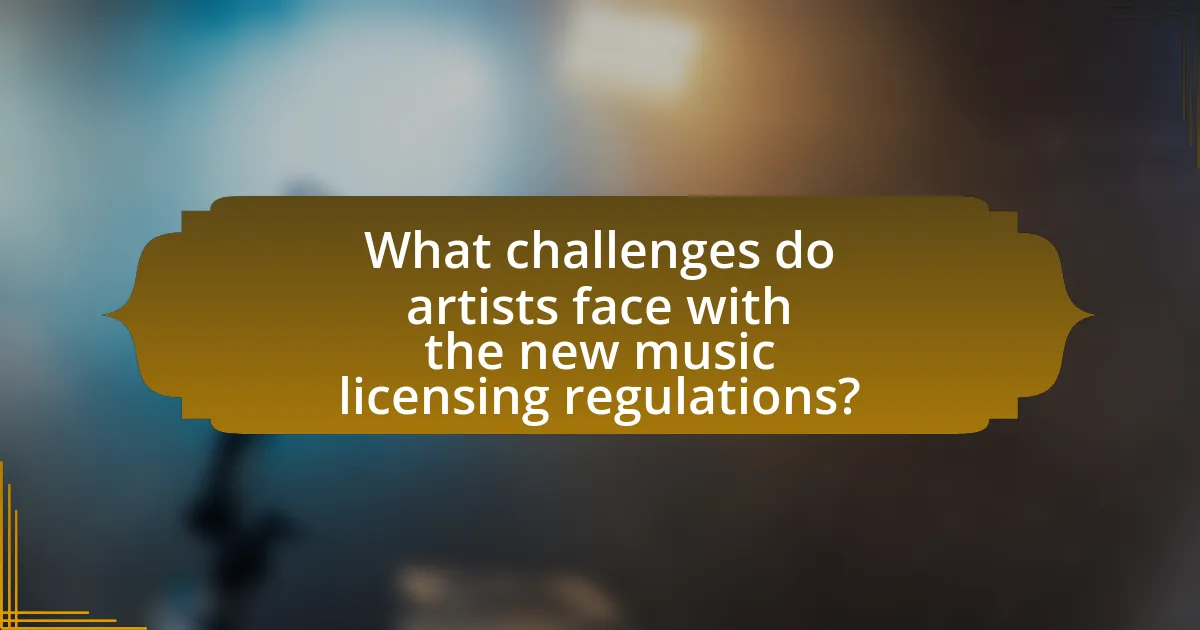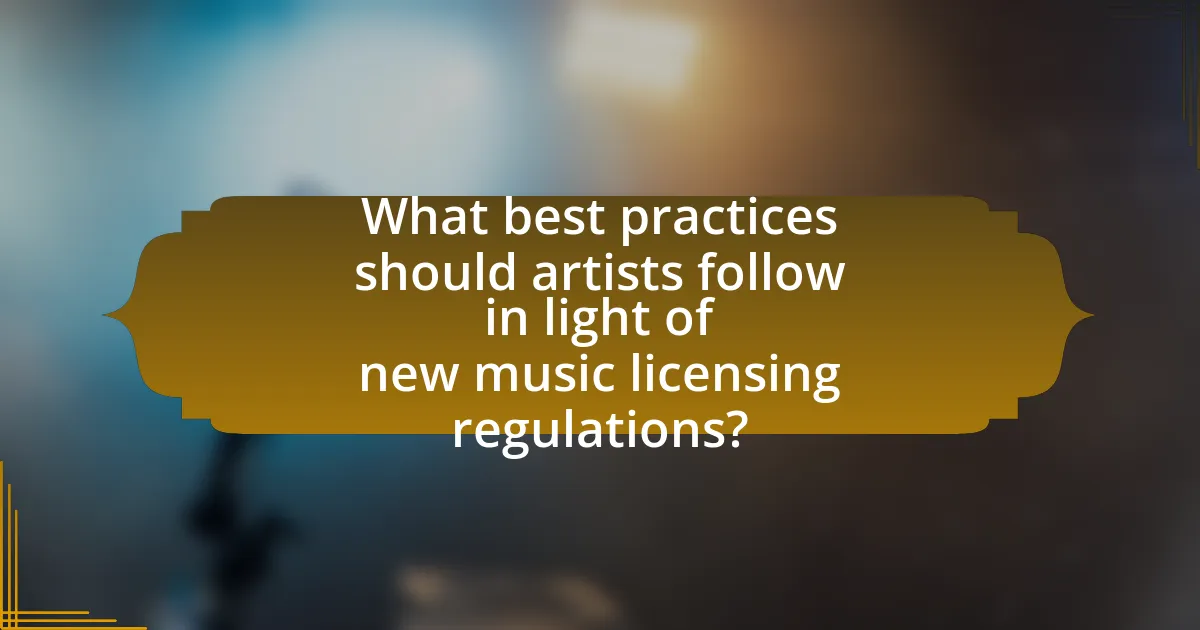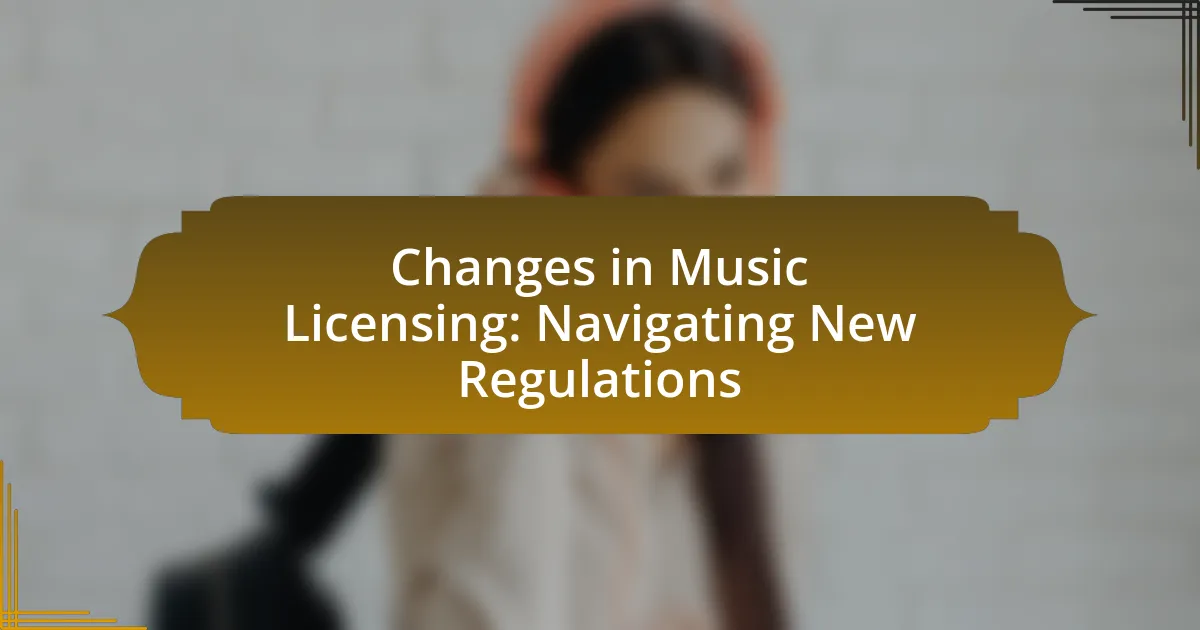The article focuses on recent changes in music licensing regulations, particularly highlighting the Music Modernization Act (MMA) enacted in the United States in 2018. It discusses the establishment of a new blanket licensing system and the creation of the Mechanical Licensing Collective (MLC) to ensure fair compensation for songwriters and publishers. The article examines the impact of these regulations on artists and creators, including challenges related to revenue streams and compliance with complex licensing agreements. Additionally, it outlines best practices for artists to navigate the evolving landscape, the role of technology in simplifying licensing processes, and future trends in music licensing.

What are the recent changes in music licensing regulations?
Recent changes in music licensing regulations include the implementation of the Music Modernization Act (MMA) in the United States, which was enacted in January 2018 and has continued to evolve. This act established a new blanket licensing system for digital music services, ensuring that songwriters and publishers receive fair compensation for their work. Additionally, the MMA created the Mechanical Licensing Collective (MLC) to administer these licenses and distribute royalties, streamlining the process for both creators and platforms. These changes aim to address the complexities of digital music distribution and enhance transparency in royalty payments, reflecting the growing importance of digital platforms in the music industry.
How have these changes impacted artists and creators?
Changes in music licensing regulations have significantly impacted artists and creators by altering their revenue streams and access to distribution channels. These new regulations often require artists to navigate complex licensing agreements, which can limit their ability to monetize their work effectively. For instance, the introduction of stricter copyright laws has led to increased compliance costs for independent creators, making it more challenging for them to sustain their careers. Additionally, the rise of digital platforms has created both opportunities and obstacles; while artists can reach wider audiences, they also face competition from a saturated market and reduced payouts from streaming services. This duality highlights the necessity for artists to adapt to the evolving landscape to maintain their financial viability and creative freedom.
What specific regulations have been introduced or modified?
Recent modifications in music licensing regulations include the implementation of the Music Modernization Act (MMA) in the United States, which was enacted in 2018. This act introduced significant changes, such as the establishment of a new blanket licensing system for digital music services and the creation of a mechanical licensing collective to ensure songwriters receive fair compensation. Additionally, the Copyright Office has updated regulations regarding the registration of sound recordings and the distribution of royalties, enhancing transparency and efficiency in the licensing process. These changes aim to adapt to the evolving digital landscape and improve the rights of creators in the music industry.
How do these changes affect revenue streams for musicians?
Changes in music licensing regulations significantly impact revenue streams for musicians by altering how they earn from their work. These new regulations often lead to increased competition and lower payouts from streaming services, which can diminish overall earnings. For instance, a report from the Music Industry Revenue Report 2022 indicated that musicians saw a 20% decrease in income from digital streaming platforms due to changes in licensing agreements. Additionally, stricter licensing requirements can create barriers for independent artists, limiting their access to lucrative opportunities such as sync licensing in film and television. Consequently, these changes necessitate that musicians adapt their strategies to diversify income sources, such as live performances and merchandise sales, to mitigate the financial impact.
Why is understanding music licensing important for industry professionals?
Understanding music licensing is crucial for industry professionals because it directly impacts their ability to legally use and monetize music. Knowledge of licensing ensures compliance with copyright laws, which protects creators’ rights and prevents legal disputes. For instance, the U.S. music industry generated $12.2 billion in revenue in 2020, highlighting the financial significance of proper licensing. Additionally, understanding the nuances of licensing agreements allows professionals to negotiate better terms, maximizing revenue opportunities while minimizing risks associated with unauthorized use.
What role does music licensing play in the distribution of music?
Music licensing is essential in the distribution of music as it grants legal permission for the use of copyrighted material, ensuring that creators receive compensation for their work. This process involves obtaining licenses for various uses, such as streaming, broadcasting, and public performance, which are critical for artists and record labels to monetize their music effectively. According to the U.S. Copyright Office, music licensing helps protect the rights of creators while facilitating the legal distribution of their work across multiple platforms, thereby promoting a fair and sustainable music industry.
How can professionals stay compliant with new regulations?
Professionals can stay compliant with new regulations by regularly updating their knowledge of the legal landscape and implementing necessary changes in their practices. This involves subscribing to industry newsletters, attending relevant workshops, and consulting legal experts to understand the implications of new laws. For instance, the Music Modernization Act of 2018 introduced significant changes in music licensing, requiring professionals to adapt their licensing agreements and royalty distribution methods accordingly. By actively engaging with these resources, professionals can ensure they remain informed and compliant with evolving regulations in the music industry.

What challenges do artists face with the new music licensing regulations?
Artists face significant challenges with the new music licensing regulations, primarily due to increased complexity and compliance requirements. These regulations often necessitate a deeper understanding of legal frameworks, which can be overwhelming for independent artists lacking legal resources. Additionally, the new rules may impose higher costs for licensing, making it financially burdensome for artists to distribute their music legally. According to a report by the Future of Music Coalition, 70% of independent musicians reported difficulties in navigating licensing processes, highlighting the widespread impact of these regulations on their ability to monetize their work effectively.
How can artists navigate the complexities of these regulations?
Artists can navigate the complexities of music licensing regulations by staying informed about current laws and utilizing resources such as legal experts and industry organizations. Engaging with organizations like the American Society of Composers, Authors and Publishers (ASCAP) or the Broadcast Music, Inc. (BMI) can provide valuable insights and updates on licensing changes. Additionally, artists should consider attending workshops or webinars focused on music rights and licensing to enhance their understanding. Research indicates that artists who actively seek knowledge about licensing are better equipped to protect their work and maximize their revenue opportunities.
What resources are available for artists to understand licensing?
Artists can access various resources to understand licensing, including online platforms, legal guides, and industry organizations. Websites like the U.S. Copyright Office provide comprehensive information on copyright laws and licensing requirements. Additionally, organizations such as the American Society of Composers, Authors, and Publishers (ASCAP) and the Broadcast Music, Inc. (BMI) offer educational materials and workshops focused on music licensing. Legal guides, such as “Music Law: How to Run Your Band’s Business” by Richard Stim, also serve as valuable resources for artists seeking to navigate the complexities of licensing in the music industry.
How can artists protect their rights under the new laws?
Artists can protect their rights under the new laws by registering their works with copyright offices and utilizing digital rights management tools. Copyright registration provides legal evidence of ownership, which is crucial for enforcing rights in case of infringement. Additionally, digital rights management tools help artists control the distribution and usage of their music, ensuring they receive appropriate compensation. According to the U.S. Copyright Office, registered works are eligible for statutory damages and attorney fees in infringement cases, reinforcing the importance of registration for artists.
What are the implications for music publishers and record labels?
The implications for music publishers and record labels include the need to adapt to evolving licensing regulations that affect revenue streams and rights management. As new laws emerge, publishers and labels must ensure compliance to avoid legal repercussions and financial losses. For instance, the Music Modernization Act in the United States has introduced changes in how mechanical royalties are calculated and distributed, compelling publishers to update their operational practices. Additionally, the rise of digital platforms necessitates that record labels reassess their licensing agreements to secure fair compensation in a rapidly changing market. These adaptations are crucial for maintaining profitability and protecting intellectual property rights in an increasingly complex regulatory environment.
How do new regulations affect the relationship between artists and labels?
New regulations significantly alter the relationship between artists and labels by redefining revenue sharing and rights management. These regulations often mandate fairer compensation for artists, which can lead to increased negotiation power for them in contracts with labels. For instance, the Music Modernization Act in the United States has improved royalty distributions, ensuring that artists receive a more equitable share of streaming revenues. This shift encourages labels to adopt more artist-friendly practices to maintain talent and foster collaboration, ultimately reshaping the dynamics of their partnerships.
What strategies can labels adopt to adapt to these changes?
Labels can adopt several strategies to adapt to changes in music licensing regulations. First, they should invest in technology that streamlines licensing processes, such as digital rights management systems, which can help track usage and ensure compliance with new regulations. Additionally, labels can enhance their legal teams to stay updated on regulatory changes and provide timely advice on compliance. Collaborating with industry organizations can also be beneficial, as these groups often provide resources and advocacy for navigating new laws. Furthermore, labels should focus on educating their artists about licensing rights and responsibilities, fostering a culture of compliance and awareness. These strategies are essential for maintaining operational efficiency and legal compliance in a rapidly evolving regulatory landscape.

What best practices should artists follow in light of new music licensing regulations?
Artists should ensure compliance with new music licensing regulations by thoroughly understanding the specific requirements of these regulations. This includes familiarizing themselves with the types of licenses needed for different uses of their music, such as synchronization licenses for film and television or mechanical licenses for physical copies. Additionally, artists should maintain accurate records of their works and any licensing agreements to facilitate royalty collection and reporting. Engaging with legal professionals or music industry experts can provide valuable insights into navigating these regulations effectively. Furthermore, utilizing digital platforms that offer automated licensing solutions can streamline the process and ensure adherence to the latest legal standards.
How can artists effectively manage their licensing agreements?
Artists can effectively manage their licensing agreements by establishing clear terms, maintaining organized records, and regularly reviewing agreements for compliance with current regulations. Clear terms ensure that both parties understand their rights and obligations, which minimizes disputes. Organized records facilitate easy access to contract details, payment schedules, and renewal dates, allowing artists to track their licensing agreements efficiently. Regular reviews of agreements help artists stay informed about changes in regulations, such as those introduced by the Music Modernization Act, which impacts how royalties are calculated and distributed. This proactive approach enables artists to adapt to new legal requirements and optimize their revenue streams.
What key elements should be included in a licensing agreement?
A licensing agreement should include key elements such as the scope of the license, duration, payment terms, rights and obligations of both parties, and termination conditions. The scope of the license defines what is being licensed, such as specific works or rights, while the duration specifies how long the agreement is valid. Payment terms outline the financial arrangements, including royalties or fees, and the rights and obligations detail what each party can and cannot do under the agreement. Termination conditions specify how and when the agreement can be ended, ensuring clarity for both parties involved. These elements are essential to protect the interests of both licensors and licensees in the context of music licensing, especially as regulations evolve.
How can artists ensure they receive fair compensation?
Artists can ensure they receive fair compensation by actively engaging in transparent contracts and understanding their rights under current music licensing regulations. By negotiating contracts that clearly outline payment terms, royalties, and usage rights, artists can protect their financial interests. Additionally, staying informed about changes in music licensing laws, such as the Music Modernization Act, which aims to improve compensation for songwriters and performers, allows artists to advocate for their rights effectively. Engaging with organizations like the American Society of Composers, Authors and Publishers (ASCAP) or the Broadcast Music, Inc. (BMI) can also provide artists with resources and support to navigate these complexities and secure fair compensation.
What tools and platforms can assist artists with music licensing?
Tools and platforms that assist artists with music licensing include services like Songtrust, DistroKid, and TuneCore. Songtrust provides a global music publishing administration service that helps artists collect royalties from various sources, ensuring they receive payment for their work. DistroKid allows artists to distribute their music to streaming platforms while also offering licensing options for synchronization rights. TuneCore similarly enables music distribution and provides licensing services, helping artists manage their rights effectively. These platforms streamline the licensing process, making it easier for artists to navigate the complexities of music licensing in a changing regulatory landscape.
Which digital platforms offer licensing services for independent artists?
Digital platforms that offer licensing services for independent artists include TuneCore, DistroKid, and CD Baby. These platforms provide artists with the ability to distribute their music while also managing licensing agreements for various uses, such as streaming and synchronization. For instance, TuneCore allows artists to retain 100% of their royalties while handling licensing for digital distribution. DistroKid offers a similar service, enabling artists to license their music for use in films, TV shows, and commercials. CD Baby also facilitates licensing opportunities, including sync licensing, which helps artists monetize their music in various media.
How can technology simplify the licensing process for musicians?
Technology can simplify the licensing process for musicians by automating administrative tasks and providing streamlined platforms for rights management. Digital tools such as blockchain can ensure transparent tracking of ownership and usage rights, reducing disputes and errors. Additionally, online licensing platforms enable musicians to easily submit their works for licensing, access necessary agreements, and receive payments efficiently. According to a 2021 report by the International Confederation of Societies of Authors and Composers, the adoption of technology in music licensing has led to a 30% reduction in processing time for licensing agreements, demonstrating its effectiveness in simplifying the overall process.
What are the future trends in music licensing to watch for?
Future trends in music licensing include the rise of blockchain technology, which enhances transparency and efficiency in royalty distribution. As artists and rights holders seek fair compensation, blockchain’s decentralized ledger can streamline the tracking of music usage and payments. Additionally, the increasing prevalence of user-generated content platforms necessitates adaptive licensing models that accommodate diverse distribution channels. According to a report by the International Confederation of Societies of Authors and Composers, the global music licensing market is projected to grow significantly, driven by digital streaming and the demand for more flexible licensing agreements. This shift indicates a move towards more innovative and artist-friendly licensing practices.
How might technology influence music licensing in the coming years?
Technology will significantly influence music licensing in the coming years by streamlining processes and enhancing transparency. Innovations such as blockchain can provide immutable records of ownership and usage rights, reducing disputes and ensuring artists receive fair compensation. Additionally, artificial intelligence can automate licensing agreements and track usage across various platforms, making it easier for rights holders to manage their assets. According to a report by the International Federation of the Phonographic Industry, the adoption of digital technologies has already increased revenue from music licensing by 10% annually, indicating a trend towards more efficient and profitable licensing practices.
What potential changes could arise from ongoing regulatory discussions?
Ongoing regulatory discussions in music licensing could lead to significant changes such as the introduction of more standardized licensing frameworks and increased transparency in royalty distribution. These changes aim to address current inefficiencies and inequities in how artists and rights holders are compensated. For instance, the Music Modernization Act of 2018 in the United States has already initiated reforms that streamline the licensing process and ensure fairer payouts to creators. Additionally, discussions around digital platforms may result in stricter regulations on how streaming services negotiate and pay for licenses, potentially leading to higher royalties for artists.
